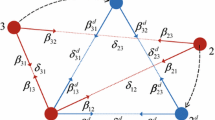Abstract
This research considers the teleoperation of an articulated robot arm by means of force-free control and visual servo control (VSC) over communication channels using the Internet technology. A semi-autonomous type teleoperation system contains a human supervisory control and VSC schemes and switches one scheme to another for accomplishing the required task accurately. The main investigation is carried out to find how it effectively improves the accuracy and the effectiveness of the teleoperation after provision of a visual feedback channel to the system. The system accuracy, effectiveness, repeatability and handleability based on the human operator’s skills and operator’s cognitive aspects are evaluated using experimental results and statistical data analysis. Effectiveness of the statistical analysis is assured by increasing the number of experiment data and assuming environmental factors, and implicit variables maintain to be unchanged. Correlation coefficients are calculated to find out how controlled input parameters are related to the successful output given by the system.




Similar content being viewed by others
Explore related subjects
Discover the latest articles and news from researchers in related subjects, suggested using machine learning.References
Stevens WR (1998) Unix Network Programming, Networking APIs: sockets and XTI, Chap 1–2. Prentice Hall, Upper Saddle River, pp 25–94
Goldberg K (2000) The robot in the garden: telerobotics and telepistemology in the age of the Internet. MIT Press, Cambridge, pp 180–320
Taylor K, Trevelyan J (1995) A telerobot on the World Wide Web. In: National conference of the Australian Robot Association. Australian Robotics Association, Melbourne, pp 108–120
Taylor K, Dalton B (1997) Issues in Internet telerobotics. International conference on field and service robotics (FSR 97). The Australian National University, Canberra, pp 151–157
Teresa T, Zhang H (1999) Internet-based tele-manipulation. In: Proceedings of the 1999 IEEE Canadian conference on electrical and computer engineering. Shaw Conference Center, Edmonton, Alberta, pp 1425–1430
Conway L, Volz RA, Walker MW (1993) Teleautonomous systems: projecting and coordinating intelligent action at a distance. IEEE Trans Robot Autom 6(2):146–158
Sheridan TB (1992) Telerobotics, automation and human supervisory control. MIT Press, Cambridge, pp 239–280
Norman DA, Draper SW (1986) User centered system design: new perspectives on human–computer interaction. Lawrence Erlbaum Associates, Hillsdale, pp 12–86
Howie DE, Janzen ME, Vicente KJ (1996) Research on factors influencing human cognitive behaviour (III). CEL Technical Reports Series, CEL No. 96-06
Goto S (2010) Teleoperation system of industrial articulated robot arms by using forcefree control, robot manipulators trends and development, Chap 15. Advanced Robotic Systems International, IN-TECH, pp 321–334
Hutchinson S, Hager GD, Corke PI (1996) A tutorial on visual servo control. IEEE Trans Robot Autom 12(5):651–670
Pallegedara A, Matsuda Y, Matsumoto T, Tsukamoto K, Egashira N, Goto S (2011) Remote control of robot arms via network by force-free control followed template matching. In: Proceedings of the SICE annual conference 2011, September 13–18, Tokyo pp 940–945
Comer DE, Stevens DL (2001) Internetworking with TCP/IP, vol III: client–server Programming and applications Linux/POSIX Sockets Version. Prentice Hall, New Jersey, pp 10–97
Goto S (2007) Forcefree control for flexible motion of industrial articulated robot arm. Industrial robotics: theory, modeling and control, Chap 30. Advanced Robotic Systems International, pro literatur Verlag, pp 813–840
Burt PJ, Yen C, Xu X (1982) Local correlation measures for motion analysis: a comparative study. In: Proceedings of the IEEE conference on pattern recognition and image processing, pp 269–274
Lam SK, Yeong CY, Yew CT, Chai WS, Suandi SA (2010) A study on similarity computations in template matching technique for identity verification. Int J Comput Sci Eng 02(08):2659–2665
Hannaman GW, Spurgin AJ, Luckic YD (1985) A model for assessing human cognitive reliability in PRA studies. In: Proceedings of the IEEE conference on human factors and power plants, pp 343–353
Author information
Authors and Affiliations
Corresponding author
About this article
Cite this article
Pallegedara, A., Matsuda, Y., Egashira, N. et al. Experimental evaluation of teleoperation system with force-free control and visual servo control by human operator perception. Artif Life Robotics 17, 388–394 (2013). https://doi.org/10.1007/s10015-012-0074-9
Received:
Accepted:
Published:
Issue Date:
DOI: https://doi.org/10.1007/s10015-012-0074-9




